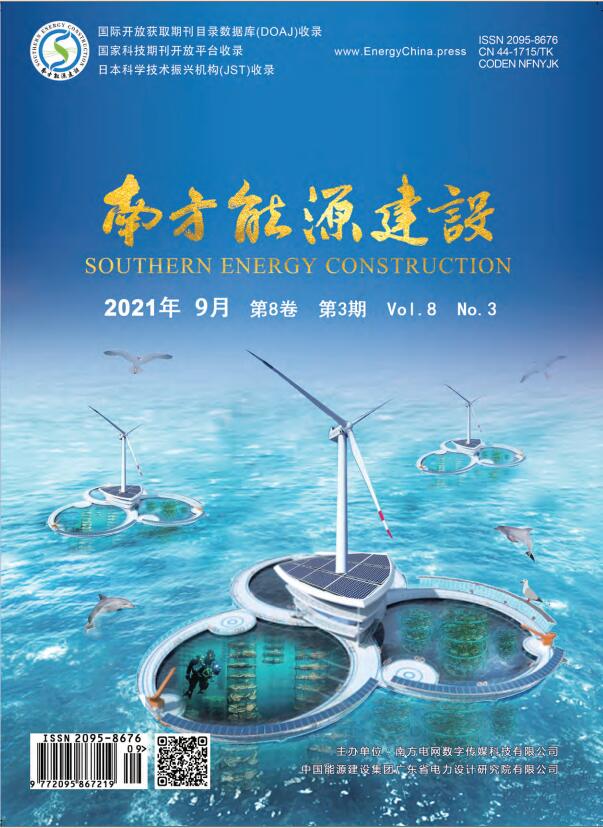-
温室气体排放是人为驱动全球气候变化的主要原因[1]。随着碳中和和碳达峰目标的持续推进,可再生能源将在减少排放、同时保持经济的发展速度和规模方面发挥重要作用。与所有可再生能源生产一样,风能是一种可持续资源,其碳足迹远低于燃烧化石燃料,是一种重要的可再生能源[2]。近年来,我国的风电场数量迅速增加。政府的目标是到2030年10%的能源来自可再生能源,其中7%~8%将来自风能。据估计,到2030年底,广东省将建成投产海上风电装机容量约30 GW以实现这一目标。海上风力发电可以为我国应对全球气候变化、实现碳中和做出积极贡献。然而,风力涡轮机对周边环境,尤其是鸟类存在潜在影响。这些潜在影响包括直接与涡轮叶片碰撞而造成的死亡、或间接栖息地丧失造成的迁移、屏障效应等[3]。除此之外,风电也是我国发展最快的能源行业之一,我国2020年电力行业新增装机容量为190.87 GW,其中风电新增装机容量达71.67 GW,占2020年电力行业新增装机容量的37.5%,仅广东一省开工建设海上风电装机容量就超过12 GW。相对于大规模的海上风能开发,对海上风电场对鸟类的影响研究并不多。本文将从海上风电场对鸟类影响的来源、结果和如何有效预防等三个角度进行综述,为我国发展海上风电的同时,在风电场的设计、建设和运营阶段完成对鸟类的保护工作,以避免对脆弱的鸟类生态系统造成破坏。
HTML
-
风力涡轮机叶片的机械撞击是鸟类死亡的直接原因。鸟类可能因与风力涡轮机的旋转螺旋桨相撞而死亡,也可能因与涡轮塔、机舱或风电场中的其他结构(如拉索、电力线和气象桅杆)相撞而受到致命伤害[4]。与风机涡轮叶片碰撞造成鸟类死亡的两个最著名的案例分别发生在加利福尼亚的阿尔塔蒙特山口风电场[5]和西班牙南部的塔里法风电场[6]。大量的猛禽在这些地点与风力涡轮机相撞,包括大量的金鹰(Chrysaetosat altamont)和狮鹫(Gyps fulvus)[7]。像鹰、鹫这样的大型长寿物种通常受到其死亡率的微小增加的影响,而导致整个种群数量的降低。据估计,美国每年平均有23.4万只鸟类因与单极风力涡轮机的碰撞而死亡;对于整个北美洲,风力涡轮机每年要杀死约32.8万只鸟,使采用风力涡轮机的风力发电成为对鸟类最具威胁的绿色能源形式[8]。小型雀鸟(鸣禽)是因与风能设施中的涡轮机碰撞而导致死亡的鸟类,每年约有13.4万只至23万只小型雀鸟因与风力涡轮机碰撞而死亡[9]。美国鸟类保护协会最新估算的数据比过去研究者估计的更高——根据现有的风机数量计算,2021年死于风电叶片的鸟类数量约有68.1万只[10]。然而,并不是所有的风电场都会发生鸟类撞击风机叶片的事件,例如:对直布罗陀海峡上的风电场的研究表明,翱翔的鸟类可以检测到涡轮机的存在,因为它们在靠近涡轮机飞行时会改变飞行方向,而且它们的数量似乎没有受到影响 [11]。美国风能协会计算出,就目前的鸟类死亡率而言,每250只与人类有关的鸟类死亡中,仅有1只是因风能利用造成的死亡[5]。
Langston和Pullan [12]建议考虑鸟类在白天和夜间的行为不同而导致撞击风险的差异,因为鸟类在这些场景中的不同行为——例如夜间风电桩上的灯光会吸引昆虫和一些鸟类前往,但此时较差的能见度可能会增加鸟类被撞击的风险。恶劣的天气和光照条件,如雾、雨、强风或黑夜,会降低鸟类的能见度和飞行高度。这可能会导致更多的撞击[13]。然而,由于在这些条件下观察鸟类很困难,碰撞与恶劣的天气和光照条件之间的相关性尚不明确。除此之外,季节也是一个因素,Smallwood和Thelander[5]发现在冬季和夏季的几个月里,风力涡轮机导致了更多的鸟类死亡事件。季节因素可能与天气、鸟类繁殖等周期性差异有关。
-
风力涡轮机运行产生的噪音和湍流气流可能会吓跑鸟类并缩小它们的领地,这也会影响鸟类的繁殖、迁徙、觅食和通信等行为。对明尼苏达州西南部的布法罗岭风电场的研究表明,涡轮机噪音和涡轮机的物理运动可能会干扰筑巢的鸟类[14]。Zwart等[15]的研究表明,人为噪音可能会影响鸟类的领土行为。当海上风电涡轮机噪音存在时,知更鸟无法正常发出低频鸣叫声。而这种低频叫声是知更鸟用于阻吓入侵者的工具。因此,风力涡轮机噪音削弱了它们阻止入侵者的能力,导致额外时间和精力的消耗,增加受伤的风险,并因此降低繁殖成功率。同样,噪声对鸟类的影响也存在争议,Nazir等[16]认为风力涡轮机在距离350 m以外的地方,噪声比一台家用冰箱的都小,因此不必过度考虑风电噪音对鸟类的影响。
-
目前没有明显的证据表明,风电场的电磁辐射会对鸟类造成影响。
1.1 风力涡轮机叶片的撞击
1.2 噪声的作用
1.3 电磁场的作用
-
海上风电场对鸟类栖息地的影响,有正反两个方面的效应。
不利的影响主要表现为部分鸟类物种会因风电场的建设而被迫迁移栖息地。如:Gonzalez等[17]发现啄食黑松鸡(Tetrao tetrix)在风电场建设后在本地发生迁移,但它们只是迁离了风电场500 m范围之外,总的数量并没有变化。鸟类因栖息地丧失而被迫迁移的案例很多[18-19]。尤其是风电场建设对生活在其周边区域内的鸟类种群影响最大。当面临批准风电场选址的决定时,有必要考虑针对敏感物种的影响变化。红喉潜鸟(Gavia stellata)和黑海番鸭(Melanitta nigra)在建设前的Horns Rev海上风电场区域内被发现,但在建造后几乎完全不存在[20],而普通海番鸭却已经开始在涡轮机之间自由觅食。Nysted海上风电场的一些长尾鸭(Clangula hyemalis)仍然可以活动在风电场涡轮机之间,但密度低于建造前 [21]。通过对挪威西部47个鹰领地10年的观测数据,沿海风电场影响了白尾鹰的繁殖成功率[22]。Xu等[23]研究了崇明东滩风电场对小白鹭(Egretta garzetta)丰度和能量预算相关行为的影响,发现到风电场的距离对小白鹭的丰度没有显著影响。
风电场对鸟类栖息地也有正面的研究报道。研究发现,涡轮机结构可以充当人工鱼礁,可能会增加结构多样性并创造当地丰富的猎物物种。涡轮机底座周围的底栖群落的丰度和多样性比原生动物群落增加的更多[16]。这些底栖群落及其伴生的浮游生物,是鱼类的食物来源。莫爵亭等对广东阳江风电场的研究同样表明,风电海域的初级生产力明显高于周边区域[24]。此外,海上风电场禁止捕捞,导致风电场内的鱼类生物量往往比周围海域更高,从而为鸟类提供了大量的食物。因此,海上风电场开发作为人工鱼礁和“禁捕区”,为海鸟和其它海洋生物提供了新的栖息地,具有潜在的海洋保护和生物多样性效益[25]。因此,如果鸟类没有因涡轮机本身的存在而流离失所,并且没有因碰撞而导致的重大死亡,那么风电场的存在就对鸟类的生存有益。
-
风力涡轮机噪音掩盖了鸟类的交流,因此可能会影响雄性、雄性和雌性以及亲子之间的交流。欧洲知更鸟(Erithacus rubecula)的雄性互动就受到风力涡轮机噪音的影响(Garcia等,2015)[26]。由于风力涡轮机背景噪音的存在,在领土被其它雄鸟入侵期时,雄性的反应并不积极。这可能会导致繁殖成功率降低,因为雄性无法有效地保卫各自的领地[15]。类似的研究表明部分能量位于较低频率的鸟类物种的鸣叫声音都被风力涡轮机噪音掩盖了,从而影响了它们的正常呼唤、警示等交流信息[27]。我们由此可知,某些特定的鸟类受到风力涡轮机噪声影响较大。
-
风电会引起鸟类种群结构产生变化,一些对风电场适应能力较强的种类能生活在距离风电场较近的地方,而较敏感的鸟类则会迁移出去,这样就造成了风电场周边环境鸟类种群结构的变化。在德国第一个海上风电场“阿尔法文图斯”风电场的调查发现,风电场内部的鸟类丰度比风电场外低了75%~92%[28]。有3种鸟类,迁移到了离最外层涡轮机1 km以上的地方,与此相对应的是有两种海鸥被吸引到风电场内部[28]。在墨西哥瓦哈卡风电场中,随着距离风电桩机越来越远,其鸟类的群落多样性和丰度越来越高[29]。
有些鸟类虽然无法适应风电场的环境,但因其无法改变原有栖息地,则会受到致命的影响。这种影响最终也会改变当地的鸟类种群构成。例如:鸟类被风机涡轮转子撞击具有物种特异性。部分特定行为或视力敏感性的鸟类物种,会受到较大的影响,而其它一些物种则影响较小,从而改变了整个风电场周边环境的鸟类物种组成。以美国加利福尼亚州阿尔塔蒙特风电场为例,风力涡轮机每年造成数千只鸟类死亡,但死亡情况具有很强的物种特异性[6]。在最常飞过风机涡轮转子区的物种中,某些物种,如红尾鵟(Buteo jamaicensis)和美洲红隼(Falco sparverius)的死亡率很高,而其他一些鸟类的死亡率则较低,如普通乌鸦(Corvus corax)、火鸡秃鹰(Cathartes aura)等,这表明鸟类的特定行为或视力敏感性导致了这些物种对风电环境适应力的差异[6]。一些靠气流盘旋飞行的猛禽类鸟类受风机涡轮的影响较大,其死亡率随着风机涡轮转子区的距离缩短而线性增加。同样,有效栖息地丧失的程度和性质可能因物种而异。不仅行为,而且承受影响的能力可能因物种而异。寿命短的迁徙物种可能表现出很高的繁殖能力,这在正常情况下可以缓冲它们每年迁徙期间经历的非常高的死亡率。这些物种种群规模的变化对死亡率增加的响应相对迟缓;而长寿物种则不然,由于繁殖产量低,即使死亡率的小幅增加也会迅速影响种群规模。因此,在评估风电场对鸟类的影响时,考虑生态系统功能和物种之间的营养级联关系非常重要:即生态系统内发生的过程和相互作用。一个物种的存在与否,尤其是顶级捕食者,可能会影响其猎物的数量,并最终影响生态系统的组成[30]。
2.1 对鸟类栖息地的影响
2.2 对鸟类交流的影响
2.3 对鸟类种群结构的影响
-
将风电场的建设时间控制在非繁殖期有助于减少鸟类干扰的负面影响[31]。而涡轮机的位置选择则在很大程度上决定了鸟类死亡率的高低[32]。在大多数情况下,通过仔细选址,可以将自然保护的影响降到最低程度,使其不会受到重大关注。在风电场规划设计的初始阶段,使用已有生物群落及其环境信息来评估影响的大小是非常重要的。理想的情况下,这将以先发制人的战略方式进行,整理信息以确定不太可能对鸟类(或其他自然保护利益)产生重大影响的区域,并优先开发它们。在可能的情况下,风电场开发设计应尽量避开如下三类鸟类的栖息地:(1)高密度越冬或洄游水禽和涉禽的栖息地,这样的栖息地一旦受到干扰就有可能发生大规模的碰撞死亡;(2)猛禽活动水平高的地区,尤其是个体繁殖范围的核心区域,以及猛禽捕食等飞行活动集中的中心区域,当猛禽的常规飞行路线通过风电场时,碰撞几率会明显上升;(3)繁殖、越冬或迁徙种群数量较少物种的栖息地,特别是那些在濒危保护名单内的物种,它们的种群规模可能对碰撞导致的死亡率增加很敏感。总之,基于鸟类保护的海上风电场址的选取,需要对当地鸟类物种有专业的了解,才能进行细致的评估,例如:关键鸟类种群的行为、栖息地要求,以及与生产力相关的种群发展规模和物种脆弱性等。简单的环评报告不能满足这一要求。
-
雷达技术可以检测到鹰和其他鸟类何时接近。当雷达以及控制中心的人员确定鸟类在某个区域内时,涡轮机可以被减慢或关闭。事实证明,雷达系统比光学摄像头等其他系统更能分辨乌鸦(或一群昆虫)和鹰。精细的雷达技术可以降低大型物种接近风电场的风险,包括鸣鹤、秃鹰和老鹰等受保护的鸟类[33]。预警雷达技术已在鸣禽春季迁徙期间部署在得克萨斯州墨西哥湾沿岸的风电场。通过关注鸣禽迁徙时的气象条件(如:低能见度等),可以预测鸣禽可能飞得更低,更接近涡轮机,从而采取关机等相应措施,提前预防[33]。
最先进和应用最广泛的技术是使用雷达和GPS检测进入风电场的鸟群并及时关闭涡轮机以便鸟类飞过。2006年,Babcock and Brown公司率先在得克萨斯州的海湾风电项目安装了这样的系统[34]。有些风电场内对鸟类的监测和风机控制系统是用于保护特定物种的。在加利福尼亚的特哈查比山脉,风力开发商Terra-Gen定制了专门的鸟类检测系统,以保护加利福尼亚秃鹰。这是北美最大但是最受威胁的鸟类(只有大约230只在野外生存)。由于大多数秃鹰都贴有带着GPS传感器的标签,因此风电场建立了一个系统:当秃鹰在风电场的两英里范围内时,系统会在两分钟之内关闭涡轮机以避免伤害[35]。通过监测与智能控制,在强风中关闭涡轮机,可以减少利用空中气流进行盘旋或滑翔飞行的鸟类因紊流被带入风机转子的风险。这种结合监控的智能风电控制技术可以有效地减少风电场对鸟类的伤害。
-
风电场的几何形状也会影响到鸟类的种群——通过模型设计出有利于鸟类规避涡轮机叶片撞击的风电场形状,可以有效降低建设后鸟类的死亡率[36]。类似的研究表明,在风电场内留下足够大的区域没有风力涡轮机,可以确保鸟类更安全地觅食和旅行,可以最大限度地减少死亡数量。对南非开普敦西海岸规划中的风电场的白鹈鹕迁徙模拟表明,从风电场中移除五个风险最高的涡轮机,或制定在鸟类迁徙的高峰时段至少关闭这些涡轮机的限电方案,理论上可以将对鸟类迁徙的影响降低到可接受的水平[37]。
风机结构设计的改进在降低鸟类死亡率方面也很有效[38]。例如,扩大叶片和降低风力涡轮机的转速可以降低鸟类死亡率。风力涡轮机对鸟类视力的影响是鸟类与涡轮机塔架发生碰撞的原因之一。发现涂有图案的刀片可以提高猛禽的视力[39]。夜间照明可以使叶片更加显眼[40]。但是,也有研究表明涡轮机塔架上的灯可能会吸引鸟类,尤其是在恶劣的天气条件下,会增加碰撞的机会[12]。然而,Arnett等人发现无论风力涡轮机上的灯是否点亮,鸟类或蝙蝠的死亡数量都没有差异[41]。此外,目前的海上风电桩有单桩、四柱型、海上浮台型等多种类型,选择对鸟类友好(能提供更大栖息地)的桩机类型也有利于鸟类的保护。
3.1 选择合适的风电场建设时间及地点
3.2 雷达和GPS监控下的智能控制
3.3 其它的防范措施
-
无论海上还是陆地,自从风电场开始建设后,鸟类就是受影响最大的生物群落之一。因此风电场对鸟类的影响吸引了大量的科学家开展相关研究。其研究结论也形成了三类不同的观点:正面影响,负面影响和无明显影响。正面影响观点认为,海上风电场具有岛礁效应,给鸟类带来了新的落脚点和更多的食物来源,有利于鸟类的种群发展,应该积极鼓励;负面影响的观点则认为,风电场无论在建设过程,还是在运营过程中,都给鸟类带来了撞击、噪音等各种威胁,需要我们在发展风电过程中审慎考虑;而第三类研究者则认为没有直接的证据表明海上风电对鸟类有危害,或者这些危害与其他环境因子的影响相比可以忽略不计。上述三种观点都有其科学的一面,也都存在地域和考察角度上的局限性。对风电场鸟类开展更加深入的研究,将有利于我们掌握海上风电场开发建设及运营相关的鸟类生态学基本规律,形成降低生态环境负面影响的科学决策。
在我国发展碳中和的道路上,风电是一种理想的能源,在将来必将发挥巨大作用。但风电场给当地生态环境带来的影响,尤其是鸟类的影响是一个复杂的问题。在鸟类丰富的地方建造风电场,可能会对鸟类带来负面影响,但在鸟类平时不可到达的海域建设风电场,则可能为其提供新的栖息地。这些都需要根据当地的鸟类种群组成和生活习性等实际情况,开展针对性的研究和分析。同时,我国的风电产业也处于起步阶段,在后续的建设过程中,如何开展创新型设计,使风电设施对鸟类生活的影响最小化,甚至有利于鸟类的栖息和繁衍,实现人类与自然生态环境的和谐共处,是我们科研工作者未来应该努力的方向。






 DownLoad:
DownLoad: